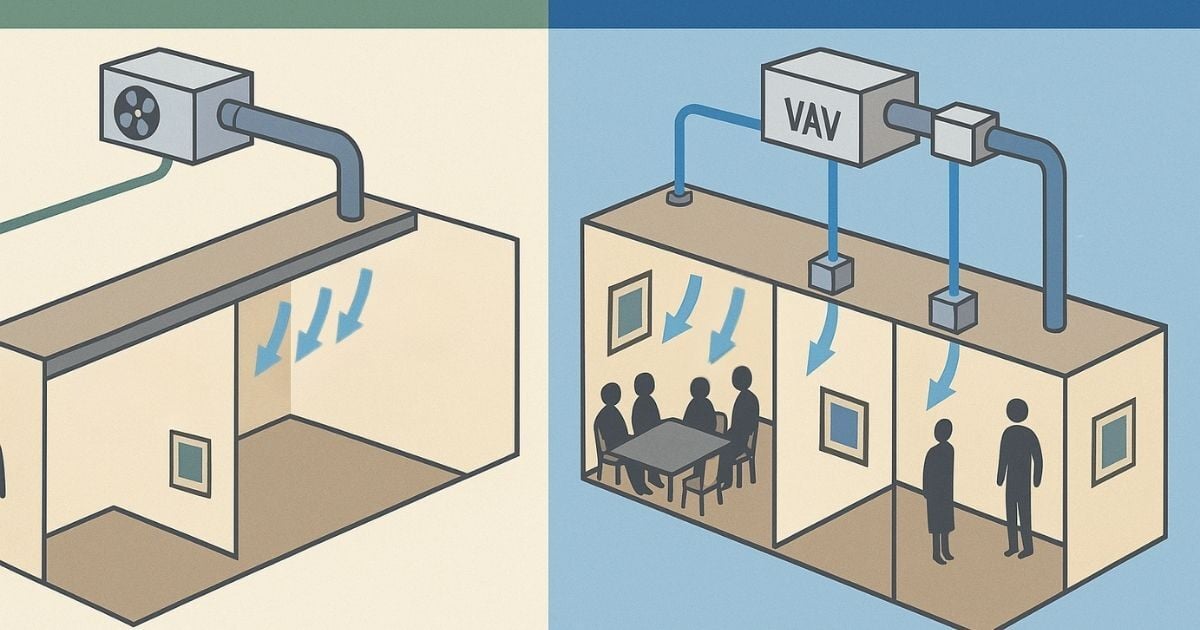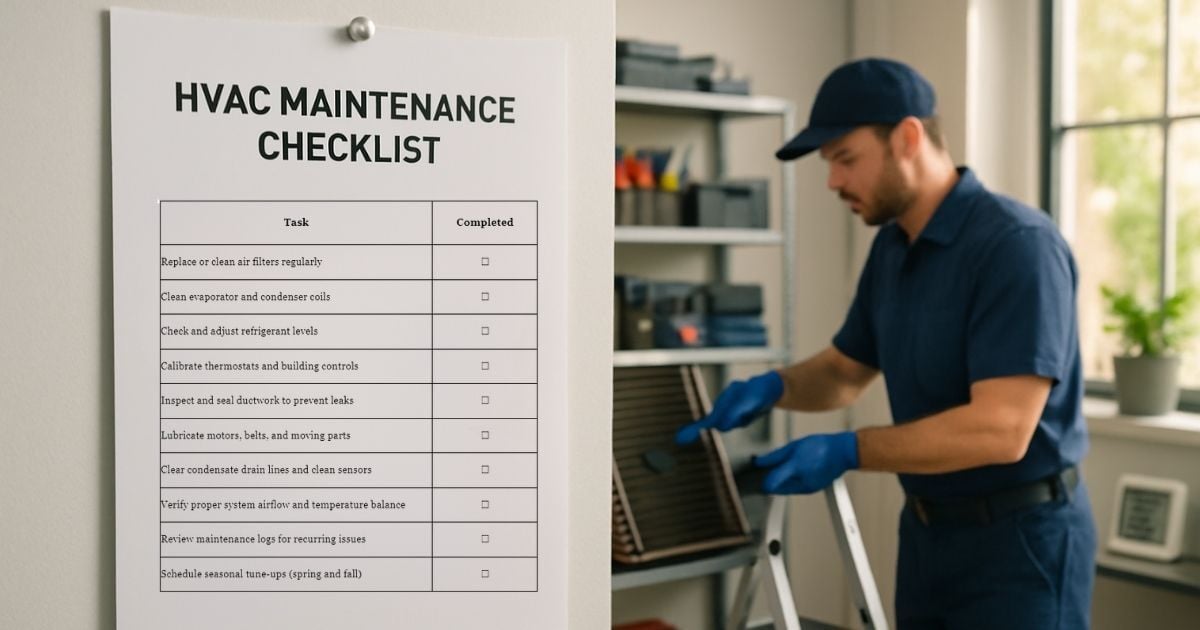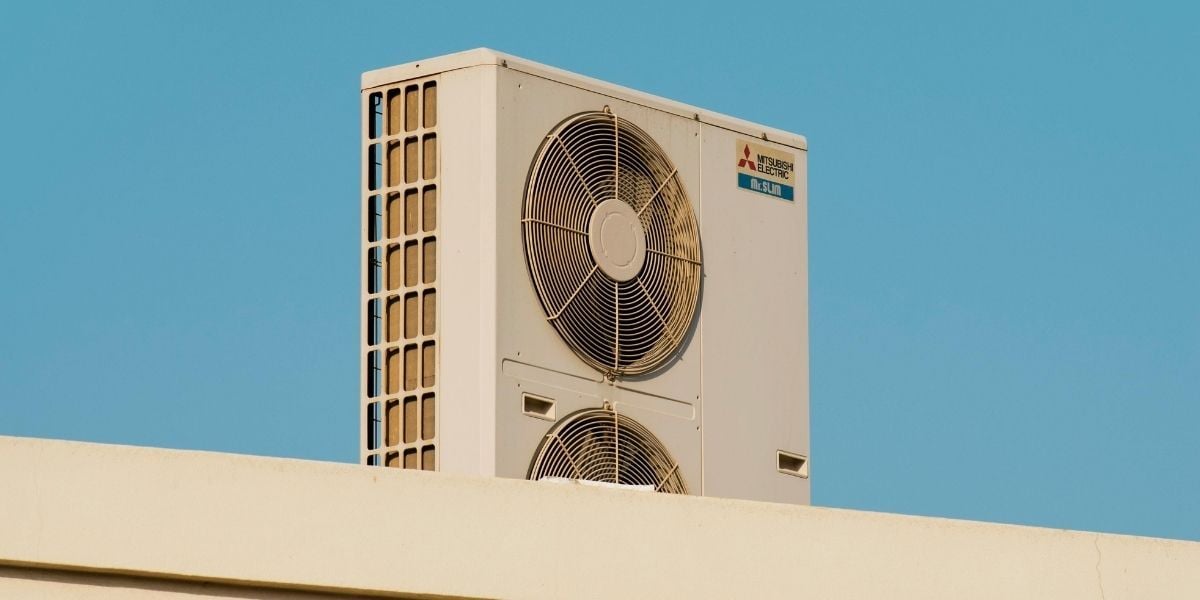Constant Air Volume vs. VAV HVAC: Which System Is Best for You?
June 30th, 2025
4 min read
By Dennis Allen

Choosing between a Constant Air Volume (CAV) and Variable Air Volume (VAV) HVAC system affects more than just comfort—it can shape your long-term energy costs, zone control, and occupant satisfaction. We're here to break down the differences clearly so you can make the best decision for your building.
At Harold Brothers, we’ve installed both Constant Air Volume and Variable Air Volume systems in a wide range of commercial buildings throughout New England. From small office retrofits to large hospital campuses, we’ve seen firsthand how CAV systems can fall short when building needs shift throughout the day. We’ve also helped clients cut energy bills and improve occupant comfort by transitioning to VAV systems that respond in real time to occupancy and load changes.
In this article, we’ll explain how CAV and VAV systems work, compare the pros and cons, and help you decide which is the right fit for your commercial space.
What Is a Constant Air Volume (CAV) System?
A constant air volume system delivers a steady stream of air at a fixed rate. To change the temperature in a space, the system adjusts the air temperature, not the amount of airflow. That means the fan runs continuously at full speed, even if the space doesn’t need it. A constant air volume HVAC system is straightforward; the airflow stays every bit as high even if cooling or heating isn’t needed, which makes it simple but less energy-efficient.
As The Engineering Mindset explains, this design is cost-effective for small, steady-use spaces like offices or storerooms, but begins to lose efficiency once you need flexibility or zoned comfort control
Because of this simple design, CAV systems are commonly used in:
- Small office buildings
- Classrooms with fixed schedules
- Retail stores
- Storage areas
One of the main benefits of a CAV HVAC system is its simplicity. These systems are easy to install and maintain, and the equipment typically costs less upfront. However, that simplicity can lead to inefficiencies. Since the fan always operates at full capacity, the system wastes energy during off-peak hours and puts more wear on mechanical parts.
Buildings with constant occupancy and uniform heating or cooling loads are often best suited for constant air volume HVAC. But as soon as you need flexibility, zoning, or smarter control, CAV starts to show its limits.
What Is a Variable Air Volume (VAV) System?
A variable air volume system works in the opposite way. Instead of changing the temperature of the air, it delivers air at a constant temperature but varies the volume of airflow. This allows the system to respond to actual building conditions in real time.
When a room is unoccupied or already cooled, a VAV system reduces the airflow. If another space heats up due to high occupancy or equipment, the system increases airflow to maintain comfort.
VAV systems are ideal for:
- Multi-zone office buildings
- Hospitals and labs
- Schools and universities
- Large commercial spaces with variable use
Because VAV systems adapt in real time, they reduce unnecessary airflow and energy waste. In addition, they reduce hot and cold spots, improve humidity control, and extend the life of HVAC components. The EPA’s "Building Air Quality Guide" for facility managers explains how well‑designed HVAC systems—with proper ventilation, filtration, and airflow control—support occupant comfort, health, and overall indoor environmental quality
Constant Air Volume vs. VAV System: Key Differences
Let’s look at a side-by-side comparison to highlight how these systems perform.
|
Feature |
Constant Air Volume (CAV) |
Variable Air Volume (VAV) |
|
Airflow Control |
Constant air flow |
Variable air volume |
|
Temperature Control |
Adjusts air temperature |
Air temperature stays constant |
|
Energy Efficiency |
Lower due to constant fan use |
Higher thanks to demand-based airflow |
|
Comfort & Zoning |
Basic, limited zoning |
Multi-zone, dynamic comfort |
|
Installation Cost |
Lower |
Higher |
|
Long-Term Energy Savings |
Moderate |
High |
|
Best For |
Small, stable-use buildings |
Large or variable-use buildings |
While CAV systems can be reliable and affordable, VAV systems tend to offer better long-term value, especially in buildings with fluctuating occupancy or temperature needs.
When to Use a Constant Air Volume System
A CAV system might be the best choice if:
- Your building has a small, open layout
- Temperature loads are consistent throughout the day
- You need a low-cost, easy-to-maintain system
- Zoning or automation isn’t a priority
Constant air volume boxes are often used in these setups, offering simple control and fewer components. If you’re retrofitting a single-zone space or working with a tight budget, CAV can still be a smart choice.
Constant air volume boxes are often used in these setups, offering simple control and fewer components. If you’re retrofitting a single‑zone space or working with a tight budget, CAV can still be a smart choice, since, as explained by Integra Controls, “a CAV system ensures space comfort by adjusting the discharge air temperature…while maintaining a constant airflow”
However, keep in mind that constant airflow means the fan never slows down, even when cooling or heating isn’t needed. Over time, this leads to higher energy bills and more maintenance.
When to Choose a Variable Air Volume System
A VAV HVAC system is likely the better choice if:
- You have multiple zones with different comfort needs
- Your building is used by many people throughout the day
- Energy savings and efficiency are priorities
- You plan to integrate with a building automation system
Because VAV systems adapt in real time, they reduce unnecessary airflow and energy waste. In addition, they reduce hot and cold spots, improve humidity control, and extend the life of HVAC components.
These benefits align with our own guidance on how to prolong the life of your commercial HVAC system, which emphasizes smarter airflow control and consistent maintenance to maximize long-term performance.
It’s worth noting that VAV boxes and controls are more complex. But the trade-off is greater comfort, smarter performance, and significant cost savings over time.
Make the Right Call for Your Commercial HVAC System
Constant air volume systems are simple, budget-friendly, and reliable. But they’re best suited for buildings with predictable, low-complexity usage.
Variable air volume systems, while more complex and costly upfront, deliver superior efficiency, comfort, and adaptability. For most large or evolving buildings, VAV is the smarter long-term investment.
Still weighing your options? Before you decide, it’s important to understand the total cost of owning and operating a commercial HVAC system. Learn more about what impacts pricing—from maintenance to energy use—in our article on commercial HVAC maintenance costs in New England.
Harold Brothers Mechanical Contractors has decades of experience designing and installing high-performance HVAC systems throughout New England. We partner with building owners to create systems that deliver comfort, efficiency, and results that last.
Dennis Allen is the COO and Director of HVAC at Harold Brothers Mechanical. With over 20 years in the trade, he leads the HVAC division and mentors the next generation of technicians. A board member for the Massachusetts Pipefitters and Refrigeration Board, Dennis is passionate about education, field excellence, and emerging technologies like VRF systems.
Topics:
























